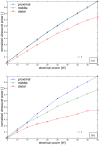Present and future technology for simultaneous superficial thermoradiotherapy of breast cancer
- PMID: 20849263
- PMCID: PMC2943851
- DOI: 10.3109/02656736.2010.493915
Present and future technology for simultaneous superficial thermoradiotherapy of breast cancer
Abstract
This paper reviews systems and techniques to deliver simultaneous thermoradiotherapy of breast cancer. It first covers the clinical implementation of simultaneous delivery of superficial (microwave or ultrasound) hyperthermia and external photon beam radiotherapy, first using a Cobalt-60 teletherapy unit and later medical linear accelerators. The parallel development and related studies of the Scanning Ultrasound Reflector Linear Arrays System (SURLAS), an advanced system specifically designed and developed for simultaneous thermoradiotherapy, follows. The performance characteristics of the SURLAS are reviewed and power limitation problems at high acoustic frequencies (>3 MHz) are discussed along with potential solutions. Next, the feasibility of simultaneous SURLAS hyperthermia and intensity modulated radiation therapy/image-guided radiotherapy (IMRT/IGRT) is established based on published and newly presented studies. Finally, based on the encouraging clinical results thus far, it is concluded that new trials employing the latest technologies are warranted along with further developments in treatment planning.
Figures




References
-
- Kampinga HH. Cell biological effects of hyperthermia alone or combined with radiation or drugs: a short introduction to newcomers in the field. Int J Hyperthermia. 2006;22:191–6. - PubMed
-
- Moyer HR, Delman KA. The role of hyperthermia in optimizing tumor response to regional therapy. Int J Hyperthermia. 2008;24:251–61. - PubMed
-
- Hildebrandt B, Wust P. The biologic rationale of hyperthermia. Cancer Treat Res. 2007;134:171–84. - PubMed
-
- Dewhirst MW, Vujaskovic Z, Jones E, et al. Re-setting the biologic rationale for thermal therapy. Int J Hyperthermia. 2005;21:779–90. - PubMed
-
- Bergs JW, Franken NA, Haveman J, et al. Hyperthermia, cisplatin and radiation trimodality treatment: a promising cancer treatment? A review from preclinical studies to clinical application. Int J Hyperthermia. 2007;23:329–41. - PubMed
Publication types
MeSH terms
Grants and funding
LinkOut - more resources
Full Text Sources
Other Literature Sources
Medical
